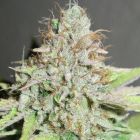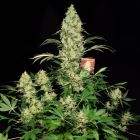Buy Cannabis Seeds

What are Cannabis Seeds?
Cannabis seeds are the product of female Cannabis plants impregnated with pollen; that said, there are several different types of cannabis seeds and phrases related to the breeding process resulting in those cannabis seeds. Cannabis seeds are usually the product of several breeding styles that produce the following forms of seeds: Regular, Feminised, Autoflowering & high CBD, all of which we stock here at Pure Sativa, providing all types of Cannabis Seeds to buy. Cannabis Seeds are all legal in the UK, as referenced in the infamous criminal case of Gypsy Nirvana, where the court cited with judicial approval that "it is not illegal to offer for sale or supply... Cannabis seeds. Breeders such as Serious Seeds & T.H.Seeds have both feminised & regular cannabis seeds for sale at Pure Sativa.
What are Regular Cannabis Seeds?
Regular seeds are bred by crossing a female variety of Cannabis with a male variety used to fertilise the female cannabis flowers, resulting in a new generation of genetics. Regular Cannabis seeds have a 50/50% chance of emerging as either male or female this follows the precise randomness intended by mother nature. Regular cannabis seeds are viewed as the most natural form of Cannabis genetics, as they are the product of pollination occurring in the same manner as in nature, and there is no tampering or tweaking involved. Regular genetics not bred into a hybrid form are still 'purebred', and these forms stem back to their landrace ancestors scattered across the globe from the rocky mountains of India to the riverside farms of South Africa. Nowadays, most regular seeds being collected or germinated are the product of breeders crossing two genetics of different subspecies, and the resulting progeny will express traits from both parent cultivars. Regular Cannabis Seeds are perfect for those who desire both male and female genetics; theoretically, these seeds often produce male and female plants, leading to further pollination and new varieties. Regular seeds are typically the best option for keeping viable and vigorous clones.
Regular Seeds are crucial for breeding and creating new strains for producing viable pollen to use as breeding stock for a new genetic line. Regular seeds offer various profiles and characteristics from current and old-school genetic lines. However, regular seeds can be unpredictable as germination can result in either male or female offspring, so it can be a gamble if one is looking for only female genetics. Additionally, it takes some knowledge to identify which are the males and which are the females & to remove them at the right point in case any unintended pollination occurs. Typically when males and females are both desired but not utilised for the next generation of breeding, they will have to be isolated in separate areas to prevent accidental pollination. We have hundreds of strains of regular cannabis seeds bred in locations across the globe.
What are feminised cannabis seeds?
Feminised cannabis seeds are a product of the human desire to get the maximum chance of viable female plants growing from seeds. Feminised cannabis seeds produce consistent results of around a 99.9% chance of female plants, so they can be a safe bet for those just after female strains and avoid pesky pollen producers. Feminised genetics are the product of two females' breeding; this can only occur when a breeder successfully reverses a female cut. The reversal produces viable pollen to create a new generation of genetics in feminised form. This might go against everything you know about breeding, as females can't produce pollen. However, this is a possible feat through the reversal process, where breeders can force female plants to make pollen sacs by stopping ethylene production in the different plant tissues. Breeders can kick-start this process using various concoctions; the standard medley used is colloidal silver which is also largely considered the safest. The other way feminised seeds are bred is because of the plant's innate desire for procreation, as unpollinated plants sometimes produce pollen. They express these hermaphrodite tendencies to ensure their genetics survive. Hermaphrodites can cause self-pollination, but breeders can collect this pollen and use it to pollinate female flowers to produce some feminised seeds. Feminised seeds are essential for birthing only resinous flowering plants & can save a bunch of time when it comes to culling & analysing the offspring. Female cannabis seeds are the most popular form of seeds on the market, and we have hundreds of different strains on offer ranging from the old to the new school!
What is an auto-flowering Cannabis Seed?
Autoflowering cannabis varieties get their name from the ability to flower without a change in the life cycle like regular or feminised seeds require to transition into the flowering stage. Autoflowering cannabis strains are very fast at flowering due to them not requiring a vegetation stage or different light cycles in the flowering stage. Breeders use a subspecies of Cannabis named Cannabis Ruderalis for breeding with other regular & feminised cannabis strains. Ruderalis hybrids are how auto-flowering cannabis strains are bred. Cannabis Ruderalis is found across Central and Eastern Europe, Russia and Central Asia, with shorter traditional growing seasons and colder environments. This harsher environment has led to an evolution of Cannabis as it can force it to begin flowering on its own accord. The Ruderalis variety life cycle is short, so rapid development is key to successful production over the season as they need to reproduce before their brief summer comes to a close & the freezing temperatures take hold of the environment. Ruderalis developed itself until it was able to flower based on the age of the plant, as opposed to notable changes in the light schedule and the hours of daylight in a day. In contrast, regular / feminised seeds are photoperiod varieties requiring a shift into fewer daylight hours to trigger the shift into the flowering stage. The reduction of daylight hours is a sign from the environment for the plants to get a move on as autumn and winter lay ahead.
Purebred Ruderalis plants exist in many areas over the landscape of many Central and Eastern European countries, Russia, and Central Asia. Still, because of their growth characteristics, you won't tend to find them outside the wild as they aren't conventionally grown by humans for medical or recreational purposes. Ruderalis grows in a shrub-like structure with a small number of cannabinoids and yields poorly. However, the subspecies is a genetic marvel, as it allows breeders to cross Ruderalis with photoperiod strains and embeds them with the auto-flowering trait. As a result of their characteristics, auto-flowering strains can work with little light or limited space. Autoflowering cannabis strains are a great purchase, as are low effort; we've tried to cherry-pick only the best auto-flowering strains for you to buy.
What is the difference between normal & CBD-dominant Cannabis Seeds?
CBD-dominant cannabis seeds are bred to contain high percentages of Cannabidiol. CBD aka Cannabidiol is a non-psychoactive compound that keeps one lucid and clear-headed whilst providing therapeutic or medicinal benefits. CBD strains can also provide recreational relaxation and come in various ratios. Some contain next to no quantities of THC, others are equal, and some have a far more significant amount of CBD than THC. Proportional ratios define these strains' cannabinoid contents, as some can be as high as 20:1 THC to CBD. CBD strains are bred by breeders searching for multiple high CBD varieties and crossing them across to each other, thus increasing the prominence of the trait over the following generations. CBD seeds are a growing area of cannabis breeding, we have only a few forms now, but they're all stellar examples providing different characteristics; Paradise Seeds have many stellar examples, and you can also find some great CBD dominant strains to buy from House Of The Great Gardener, Serious Seeds & The Original Big Buddha Family Farms.
Beyond these types of cannabis seeds is different jargon, such as F1, F2, and S1, which provide further insight into the breeding process that underpins any cannabis seed. For example, an F1 hybrid is a cannabis seed formed when pollen from a male cannabis strain impregnates a different female strain meaning it is the first generation cross. Hybrid vigour is a phrase associated with F1s. Hybrid vigour occurs when completely different genetics undergo breeding resulting in an F1 variety. Hybrid vigour means vigorous growth that occurs at a faster rate than commonly observed in other types of breeding. F1 Cannabis resembles the closest qualities to the original parents. When the next generation of parents is picked from that F1 stock and bred together, you'll have F2 cannabis seeds. Whether F1 or F2 is better is a subjective decision determined by the phenotypes found in those seeds. F2s will typically be less similar to the original parents than the F1. If parents are selected from that F2 stock and crossed together, the result will be the next generation, F3. Once this goes back to generation five or further, it is known as an Inbred line, aka IBL, all originating from breeding the descendants of the F1 Cannabis. We have a couple of new F2 cannabis strains in stock, such as Savage Hulk F2 & Terpatron 3000 F2.
Inbred line cannabis seeds, often known simply as IBL seeds, are the result of inbreeding the descendants of the F1 cannabis seeds. An IBL strain becomes a distinct strain in its own right once it is considered IBL. Because IBL Cannabis Seeds is the product of plants with close to matching genetics across multiple generations, the resulting plants usually are very consistent and provide largely predictable & repeatable results. Although going this deep into genetics breeding is challenging and can take many years, the predictability makes it worthwhile for some breeders to undertake. In addition, IBL projects are sometimes the result of a desire to ensure the survival and preservation of specific strains' unique traits, such as Sour Diesel, Skunk and many more.
How does selfing a plant produce S1 cannabis seeds?
An S1 denotation on Cannabis Seeds indicates it is the product of 'selfing'. Selfing involves using a cut from a mother plant and putting it through a process of reversal to ensure that it creates viable female pollen. As previously discussed, this reversal is generally the result of chemical treatment, which causes the female to feel stressed enough to make pollen as the last attempt to ensure its genetic makeup survives. A breeder will then collect the resulting 'selfed' pollen before applying it to the female mother plant to impregnate it with its genetics in reversed pollen. After this pollination is complete and the mother produces seeds, the resulting seeds are selfed/ self-pollinated. The resulting S1 seeds can often be incredibly stable because they use the same genetics across the male and female sides. We have a few S1 strains currently in stock, such as Holy Smoke Seeds Pancakes S1 with its buttery baked goods profile or the Sour Grape Kush S1 from Ultra Genetics which leans toward the Sour Diesel heritage. We also have a couple of Sherbert S1 hybrid strains, such as the Blue Sherbert S1 by The Plug Seedbank, whose genetics are a fusion of Blue Cookies & Sunset Sherbert & the Sherbert S1 from Pheno Finder seeds, whose lineage is studded with Girl Scout Cookies & Pink Panties DNA.
Cannabis Backcrossing
We already know what creates an F1 cannabis seed; now, if the genetics in that seed is bred back to the original parent of that F1, then this breeding process is known as backcrossing. Backcrossing can stabilise certain genetic traits through backcrossing parent genetics with genetically similar offspring. As a result, the resulting cannabis seeds can often show better genetic stability than the original parents and produce more consistent characteristics that appear more uniform than their predecessors. However, backcrossing can also be overdone; if strains are inbred too much or using the wrong ancestors, it may cause bad recessive genes to keep cropping up in the offspring. We currently have a gorgeous backcrossed cannabis stain from Grateful Seeds with their OrangeGroovye BX, a cross of Orange Groovy (Orange Cookies x 26mm) crossed back to 26mm. 26mm itself is a cross of Alien Wrench and Z Cube.
In sum, there are many different types of cannabis seeds available on the market that all produce vastly different results depending on the traits they've been bred for and the genetics used to create them. Additionally, as discussed, there are varying breeding processes that relate to how the genetics are crossed; these processes can all lead to superior benefits over other styles- it just depends on the breeding objective, the resulting phenotype found & the growing variables.









